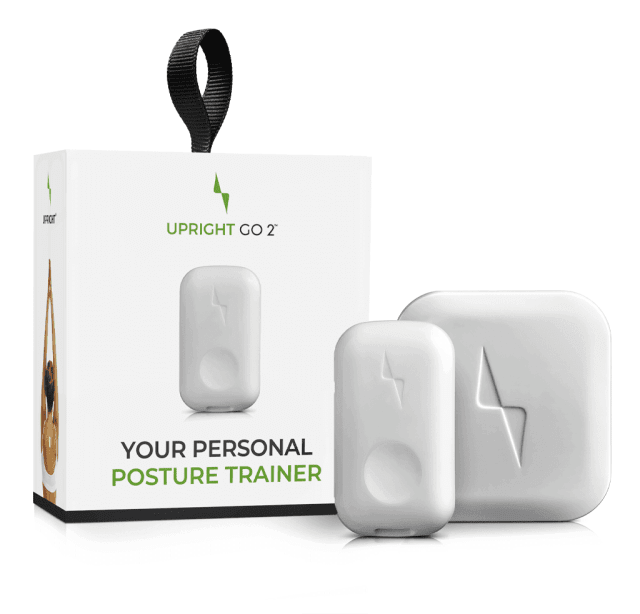How to Train Yourself to Sleep on Your Back
Max Frenkel

Learning how to sleep on your back might not feel natural at first, but it is considered one of the healthiest sleeping positions. If you’re among the lucky 13% of Americans who are able to fall asleep on their backs, you might even say it’s life-changing. But how easy is it to actually train yourself to sleep on your back if you’ve always slept on your front or side?
Let’s dive right in and explore how to train yourself to sleep on your back, including proven techniques to make the transition easier and more comfortable.
Wake up to the many benefits of better posture with the UPRIGHT GO 2.
Why Should You Learn to Sleep on Your Back?

Understanding why you should learn how to sleep on your back is crucial motivation for making this healthy change. Perhaps the most compelling reason to sleep on your back is that it keeps your spine properly aligned throughout the night.
Key Benefits of Learning How to Sleep on Your Back:
- Spinal Alignment: Maintains natural spine curves, reducing back and neck pain
- Reduced Joint Pressure: Distributes body weight evenly, ideal for arthritis sufferers
- Better Breathing: Opens airways for improved oxygen flow
- Skin Health: No face-to-pillow contact means fewer wrinkles and clearer skin
- Reduced Acid Reflux: Gravity helps keep stomach acid down
- Tension Relief: Alleviates neck, shoulder, and back tension
- Sinus Congestion Relief: Improved drainage when sleeping upright
These benefits make the effort to train yourself to sleep on your back worthwhile, even if it feels challenging at first.
How to Sleep on Your Back: Complete Training Guide

Learning how to properly sleep on your back requires patience, the right setup, and consistent practice. Here’s your step-by-step guide to mastering back sleeping:
Step 1: Get the Right Mattress Support
The foundation of learning how to sleep on your back starts with proper mattress support. Goldilocks had the right idea when she opted for the bed that was “just right.” A bed that’s too soft might sound inviting, but it won’t offer adequate support for back sleeping.
Ideal Mattress Characteristics for Back Sleeping:
- Medium-firm support: Provides spine alignment without being too hard
- Contouring ability: Supports natural body curves
- Edge support: Prevents rolling to sides during sleep
- Temperature regulation: Keeps you comfortable throughout the night
If you’re not able to spring for a new mattress, a quality mattress topper will provide an extra layer of support at an affordable price and help you learn how to sleep on your back more comfortably.
Step 2: Master Neck and Head Positioning
Proper neck support is crucial when learning how to fall asleep on your back. The goal is to maintain your neck’s natural curve while keeping your head in neutral alignment.
Pillow Options for Back Sleeping:
- Memory foam pillows: Contour to your neck’s natural shape
- Cervical support pillows: Designed specifically for neck alignment
- Adjustable pillows: Allow you to customize height and firmness
- Rolled towel technique: Budget-friendly option – place under your neck
Important: Take care not to raise your head too high, as this would put unnecessary strain on your spine and make it harder to sleep on your back comfortably.
Step 3: Support Your Knees and Lower Back
One of the most effective techniques for learning how to train yourself to sleep on your back is using knee and lower back support.
Pillow Placement Strategies:
- Under knees: Relieves lower back pressure and prevents rolling
- Lower back support: Small lumbar pillow maintains natural curve
- Between ankles: Keeps legs properly aligned
- Under calves: Alternative to knee support for some people
You’ll want to choose pillows that support your body’s natural curves. A half-moon bolster pillow can be placed under the knees, in the small of your back, between the legs, or beneath your ankles. A lumbar pillow is designed to fit the area between the upper and lower back but can also be used to prop up the knees.
How to Train Yourself to Sleep on Your Back: Advanced Techniques
Successfully learning how to train yourself to sleep on your back requires more than just pillow placement. Here are advanced strategies that will accelerate your transition:
Technique 1: Find Your Optimal Back Sleeping Position

There are several ways to position yourself when learning how to sleep on your back. Experiment with these positions to find what works best for you:
The Savasana Position (Soldier Position)
This is the most common back sleeping position, where your arms are by your sides and your legs are straight down. This position is ideal if you have shoulder pain or limited bed space.
The Starfish Position
For solo sleepers or those with larger beds, the starfish position allows you to spread your arms and legs out. This position:
- Distributes body weight more evenly
- Reduces pressure on joints
- Prevents muscle stiffening during the night
- Provides maximum comfort and freedom of movement
Note: If you have low blood pressure or poor circulation, sleeping with your arms above your head can cause your hands to fall asleep.
Technique 2: Create a Pillow Barrier System
One of the biggest challenges when learning how to train yourself to sleep on your back is staying in position throughout the night. Even if you manage to fall asleep on your back, what’s to stop you from rolling over?
Effective Barrier Methods:
- Side pillows: Place regular pillows on either side of your body
- Body pillows: Full-length pillows provide better stability
- Wedge pillows: Create a more permanent barrier
- Pool noodles: Tape to your mattress sides for a budget option
This physical barrier helps train your body to stay in the back sleeping position and prevents unconscious rolling during sleep.
Technique 3: Gradual Training Approach
Learning how to sleep on your back doesn’t have to be an all-or-nothing approach. Consider these gradual training methods:
Progressive Training Schedule:
- Week 1: Practice lying on your back for 15-30 minutes before sleep
- Week 2: Start each night on your back, allow natural movement
- Week 3: Use pillow barriers to encourage back sleeping
- Week 4+: Focus on maintaining position throughout the night
How to Fall Asleep on Your Back: Overcoming Common Challenges
Many people struggle with how to fall asleep on your back initially. Here are solutions to the most common obstacles:
Challenge 1: Feeling Vulnerable or Exposed
Solution: Use a lightweight blanket or sheet over your torso for security without overheating.
Challenge 2: Back or Hip Discomfort
Solution: Adjust pillow placement under knees and lower back. Consider a mattress topper for additional support.
Challenge 3: Difficulty Breathing
Solution: Slightly elevate your head and upper body. This is especially helpful for those with sleep apnea or congestion.
Challenge 4: Racing Thoughts
Solution: Practice relaxation techniques like deep breathing or progressive muscle relaxation while on your back.
Where Do You Put Your Arms When Sleeping on Your Back?
A common question when learning how to sleep on your back is arm positioning. Here are the best options:
Optimal Arm Positions for Back Sleeping:
1. Arms at Your Sides (Savasana Style)
- Most stable and comfortable for most people
- Prevents shoulder impingement
- Allows for natural blood circulation
- Works well in smaller beds
2. Arms Slightly Away from Body
- Reduces potential for overheating
- Comfortable for broader-shouldered individuals
- Prevents arms from falling asleep
3. One or Both Arms Above Head (Starfish)
- Good for those without circulation issues
- Requires adequate bed space
- Can help with shoulder flexibility
- May not be suitable for everyone
Arms Positions to Avoid:
- Hands behind head (can strain neck and shoulders)
- Arms crossed over chest (can restrict breathing)
- Arms tucked under body (can cause numbness)
How to Properly Sleep on Your Back: Setup Checklist
Use this comprehensive checklist to ensure you’re learning how to properly sleep on your back:
Bedroom Environment:
- ✅ Room temperature between 65-68°F (18-20°C)
- ✅ Dark, quiet environment
- ✅ Comfortable mattress with adequate support
- ✅ Quality pillows for head, neck, and knee support
Body Positioning:
- ✅ Head and neck in neutral alignment
- ✅ Shoulders relaxed and level
- ✅ Arms in comfortable position at sides
- ✅ Knees slightly bent with pillow support
- ✅ Feet naturally positioned, not forced
Support System:
- ✅ Cervical pillow or neck support
- ✅ Knee pillow for lower back relief
- ✅ Optional lumbar support pillow
- ✅ Side barriers to prevent rolling
How to Start Sleeping on Your Back: Week-by-Week Plan
Here’s a structured approach to help you learn how to start sleeping on your back successfully:
Week 1: Foundation Building
- Day 1-2: Practice lying on your back for 15 minutes before sleep
- Day 3-4: Extend practice to 30 minutes
- Day 5-7: Begin each night on your back, allow natural movement
Week 2: Position Training
- Focus: Experiment with different arm and leg positions
- Goal: Find your most comfortable back sleeping setup
- Practice: Use relaxation techniques while on your back
Week 3: Stability Training
- Introduce: Pillow barriers to encourage staying on back
- Adjust: Support pillows for optimal comfort
- Monitor: How often you stay on your back through the night
Week 4: Habit Formation
- Consistency: Start every night on your back
- Patience: Allow gradual adaptation to the position
- Assessment: Evaluate comfort and sleep quality improvements
When NOT to Sleep on Your Back
While learning how to sleep on your back offers many benefits, there are situations where it’s not recommended:
Medical Conditions That May Require Alternative Positions:
Pregnancy (Especially Third Trimester)
Pregnant women should avoid face-up snoozing as this position can put pressure on their belly and major blood vessels, potentially reducing blood flow to the baby.
Sleep Apnea
Some people with sleep apnea find that back sleeping worsens their symptoms due to gravity’s effect on soft tissues in the throat.
Acid Reflux or GERD
People who suffer from severe heartburn or acid reflux often find that sleeping on their left side aids digestion better than back sleeping.
Lower Back Issues
Some individuals with specific lower back conditions may find side sleeping more comfortable, even with proper pillow support.
Alternative Sleeping Positions: When Back Sleeping Isn’t Right
If you’ve tried learning how to train yourself to sleep on your back but it’s not working, here are healthy alternatives:
Side Sleeping (Second Best Option)
- Sleep on your left side for better digestion
- Use a pillow between your knees
- Ensure proper pillow height for neck support
- Avoid the fetal position (too curled up)
What to Avoid: Stomach Sleeping
Stomach sleeping is widely considered the worst of all sleeping positions. It puts pressure on your joints and digestive system, and forces your neck into an unnatural position. If you absolutely must sleep face down, at least place a support pillow under your neck and pelvis.
Troubleshooting Common Back Sleeping Problems
Here are solutions to frequent issues people encounter when learning how to sleep on your back:
Problem: Waking Up on Your Side
Solutions:
- Use firmer pillow barriers
- Practice relaxation techniques to sleep more deeply
- Consider a body pillow or wedge system
- Be patient – this is normal during the transition
Problem: Lower Back Pain
Solutions:
- Adjust knee pillow height and firmness
- Add lumbar support pillow
- Check mattress support level
- Try elevating legs slightly higher
Problem: Neck Stiffness
Solutions:
- Reduce pillow height
- Switch to a cervical support pillow
- Ensure head is in neutral position
- Consider a contour memory foam pillow
Problem: Feeling Restless
Solutions:
- Practice progressive muscle relaxation
- Use white noise or sleep sounds
- Ensure room temperature is optimal
- Try gentle stretching before bed
Advanced Tips for Back Sleeping Success

Sleep Environment Optimization
- Adjustable bed frames: Allow precise positioning for comfort
- Weighted blankets: Can provide security and reduce movement
- White noise machines: Help maintain deep sleep in back position
- Blackout curtains: Ensure uninterrupted sleep cycles
Pre-Sleep Routine for Back Sleepers
- Gentle stretching: Focus on hip flexors and back muscles
- Relaxation exercises: Deep breathing or meditation
- Consistent timing: Go to bed at the same time each night
- Comfortable sleepwear: Avoid restrictive clothing
Maintaining Good Posture Day and Night
Learning how to sleep on your back is just one part of maintaining optimal spinal health. Your daytime posture is equally important for overall well-being.
Training yourself to sleep on your back takes time and practice. You might find that you don’t want to lie facing up every night, especially if you have stomach issues or other health concerns. Again, everybody is different and it’s important to determine the optimal sleeping position for you.
Be patient and flexible with yourself throughout this process. Some nights will be easier than others, and that’s completely normal when learning how to train yourself to sleep on your back.
The Connection Between Sleep Position and Daily Posture
Your sleeping position affects your daytime posture, and vice versa. When you learn how to properly sleep on your back, you’re supporting the natural alignment your body needs for optimal health both during sleep and while awake.
Good spinal alignment during sleep helps:
- Reduce morning stiffness and pain
- Improve energy levels throughout the day
- Support better posture habits while sitting and standing
- Enhance overall spinal health and mobility
Now you know how to train yourself to sleep on your back, how about maintaining good posture in your waking life? Grab an UPRIGHT GO 2 today and achieve the posture of your dreams.
Conclusion: Your Journey to Better Sleep
Learning how to sleep on your back is a worthwhile investment in your health and well-being. While it may take time to adjust, the benefits of proper spinal alignment, reduced pain, and better sleep quality make the effort worthwhile.
Remember these key points as you learn how to train yourself to sleep on your back:
- Be patient: It typically takes 2-4 weeks to adjust to a new sleep position
- Stay consistent: Practice the position every night, even if you don’t stay there all night
- Optimize your setup: Invest in proper pillows and mattress support
- Listen to your body: Adjust techniques based on your comfort and any medical conditions
- Celebrate progress: Notice improvements in sleep quality and morning comfort
With patience, proper setup, and consistent practice, you can successfully learn how to sleep on your back and enjoy all the health benefits this optimal sleeping position provides. Sweet dreams!
You Might also Like
Search
Sign up to our newsletter
Follow Us On
Popular
Revisit the GO 2/S Device Setup
How to get started
Finding your upright position
How to find your target upright posture
Calibration
Check out the UPRIGHT GO 2

